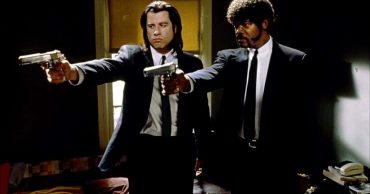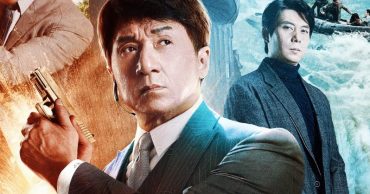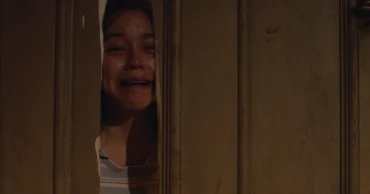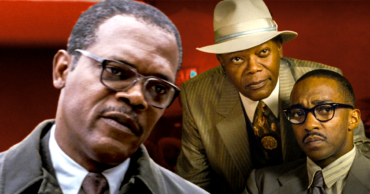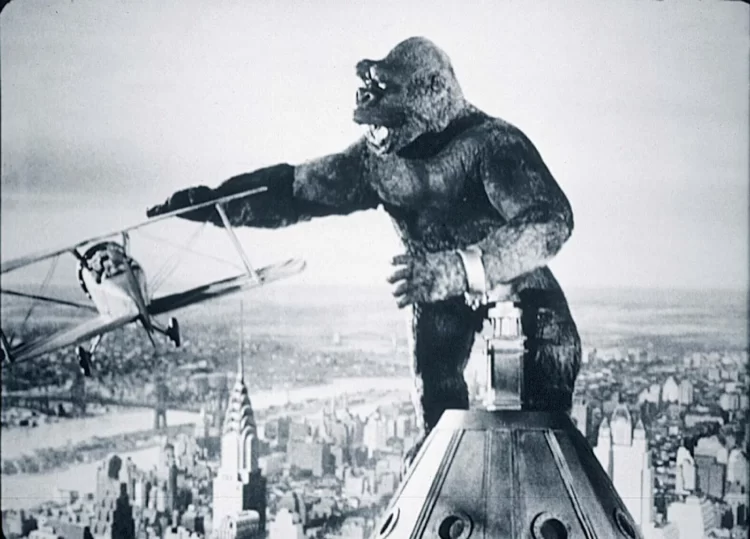
For those of us that love genre films, when we think of classic movies, it is not uncommon for King Kong (1933) to come to mind. The film has been remade twice and continued in other series, such as Legendary’s Monsterverse, numerous times. But for its fans, nothing will ever capture the awe, magic, and wonder of watching this movie for the first time. The film was directed by Merian C. Cooper and Ernest B. Shoedsack for RKO Radio Pictures and the film runs 100 minutes. It feels almost redundant to write about this film at this point if only because we all know the story so well, but even for all of the remakes and franchise explosions that have occurred with the title character as the film nears its 90th birthday–nothing matches the sheer excitement and cinematic wonder that is captured when watching the film. When we place it in the context of the early 1930s in terms of pioneering special effects and superb Classic Hollywood filmmaking on shining display, it’s easy to see why Kong has evolved for decades since. What makes the original King Kong such an important film?
What Is the Movie About?
The film tells the story of ambitious documentarian Carl Denham and the overseas voyage he takes with his crew, the ship crew, and a young, down on her luck actress named Ann Darrow who becomes Kong’s prized possession and the heroine of the film. The depiction of Depression-Era 1930s New York City, the wonder felt on Skull Island, and of course, the legendary closing segment as Kong rampages through NYC is well-known in cinema lore. But what this movie did for the film business, narrative structure, special effects, sound, cinematography, and the impact of the production inside all of the monitors that Hollywood set into place in the 1930s for measuring a film’s success, is truly remarkable. I, and countless others, feel that King Kong was unique in this pantheon of blockbuster films in how it told an unconventional story outside of the main genre tropes that studios were consistently producing in the 1930s.
Legendary Filmmaking On Display
According to Meher Tatna, the aesthetic of Jungle films was popular at the time of King Kong’s conception, Tarzan films were the rage, and Cooper and Schoedsack had made a previous animal film in 1927 called Chang: A Drama of the Wilderness about monkeys. At David O. Selznick’s RKO Studios, Cooper made The Most Dangerous Game, another animal film starring Fay Wray, directed by Schoedsack, and then used those sets to shoot King Kong. Edgar Wallace was hired to write the script with a view to capitalizing on his name. He passed away after turning in the first draft, and a number of other writers, including Schoedsack’s wife, Ruth Rose, finished the shooting script. The budget was allocated as $500,000 and pre-production on King Kong began in the spring of 1931.
Once the crew arrives at Skull Island, they encounter a tribe of natives who worship a legendary God known as “Kong.” Upon seeing Ann, the natives wish to use her as a sacrifice to appease Kong but are met with resistance. After kidnapping Ann that night from the ship’s deck, Ann is given to Kong once he appears–a 50ft tall monstrous gorilla. The ship’s crew sets out to rescue Ann from Kong and encounters many mythical monsters in the interior of the island before Jack, Ann’s love interest manages to rescue her from Kong’s lair. After a fight with the crew and the island’s natives, Carl Denham succeeds in capturing Kong to display as the “Eighth Wonder of the World” in NYC. The film’s final act takes place in NYC where Kong is able to break from his holding chains and rampages through the city in an effort to find Ann who he has become smitten with. After finding Ann, Kong climbs with her to the top of the Empire State Building where he attempts to destroy fighter planes set to destroy him. He loses the battle and falls to his death. Carl Denham utters the famous line, “it was beauty who killed the beast.”
How Was the Movie Made?
King Kong’s story and adventure have enthralled audiences for decades, but the making of the film is equally as enthralling, and a shining example of the ingenuity that many people associated with Classic Hollywood Cinema. After getting the greenlight from RKO to begin production, Cooper and Schoedsack embarked on a real odyssey to bring their fantastical vision to the screen. King Kong was filmed in several stages over an eight-month period. Cooper and Schoedsack got along decently during the filming process, specifically for all of the live-action scenes, but there were disagreements concerning all of the special effects used in the film, specifically all of the models and miniatures for Kong and the various monsters on Skull Island. Additionally, executive producer David O. Selznick was also instrumental in shaping the adventurous and awe-inspiring tone and pacing of the film. Of equal peculiarity with the production of the film was also the time-span of the production. The film would become one of cinema’s first awe-inspiring marvels in terms of special effects, and also set the template for films that use a lot of visual effects having prolonged and lengthy production schedules, which is something we see to this day. Cooper and Schoedsack employed every trick in the book, and some not yet written, to realize their monumental adventure. A combination of miniatures, traveling mattes, animation styles, rear-projected backgrounds, and other techniques each disappear into one another to create an incomparable magic show, where the impossible lives and breathes on the screen.
Part of the success of King Kong’s visualization belongs to animator and sculptor Willis H. O’Brien, whose techniques on The Lost World and the scrapped Creation landed his crew the job of a lifetime. O’Brien worked alongside Marcel Delgado, who designed the Kong puppet, to bring the great ape to life with an 18-inch miniature that he painstakingly adjusted by hand using the stop-motion process. Delgado also used an 18-foot model of Kong from the shoulders up; operated by three technicians, the larger model was used for shots that were closer or included human actors. Kong’s persona was built little by little, creating the suggestion of movement and personality through a meticulous progression. Yet, his character is pieced together from a metal skeleton frame, foam, and animal fur, making him an unlikely source of the audience’s sympathy. But miraculously, Kong conveys a singular character in motion pictures, his love for and fascination with Ann Darrow unmistakable, his final look at Ann before his death painfully sad. There are moments where Kong’s behavior and curiosity are best defined as idiosyncratic but strikingly true, such as when he verifies his Allosaurus kill by flapping its lifeless jaw, or when he smells his fingers after touching Ann. These moments grow throughout the film until the creature is no longer just a beast or a puppet, but the story’s protagonist, elevating the B-grade monster movie into a moving tragedy when Kong falls to his death.
Sound technology had only been around for five years when King Kong debuted, and the film was not only one of the first talkies to maintain a dramatic score throughout, supplied by Max Steiner, but it experimented with the interplay between diegetic and non-diegetic music as well. Listen to the aurally complex sequence when Denham’s crew spies on the Skull Island tribe’s Kong ceremony. The film layers the tribe’s thumping drum beat and singing beneath Steiner’s blazing score, resulting in two strains of music playing over the same scene, an audio strategy far more complex than the average 1930s Hollywood film. The production uses music to guide every emotion, but also to immerse the viewer with convincing sound effects. The music and sound are so innovative and unique, that I discovered new sounds upon rewatching the film. The sharp halts of sound result in a reaction during the famous sequence of Kong shaking Denham’s crew from a fallen tree. Their screams follow them into a ravine below until the sound breaks suddenly when their bodies hit the ground. Ann’s piercing screams, aided in part by the legendary Fay Wray, Kong’s grumbles, and roars, —each has a distinct personality thanks to sound designer Murray Spivack. None is more haunting than the sequence when Kong searches for Ann in New York; he grabs a random woman and, upon realizing she’s not Ann, drops her from several stories high. As she plummets to her death, her screams fade into a deafening police siren.
Reception and Legacy
Narrative strategies in film during this era were primarily concerned with immersing audiences into a world of a film. Through techniques such as the quest for order, characterization, manipulation of time, point of view, structure, and organization, films started to align into familiar patterns to tell stories without the need for reading. This was not much different from plays and theater, but the true essence of the enhancement of cinema into an artform came with the added layer of stylistic choices through the filmmaking process that also heightened the allure of the story and narrative being told. For instance, in King Kong, characterization posits that characters grow and change or experience something within a film, but the stylistic choice through something like cinematography and lighting can enhance the suggested emotions behind character choice within a film. All of the film’s human characters encounter creatures, sights, and sounds one would never dream of being part of reality, and Kong also goes on a real journey of new experiences that ultimately ends with his tragic death. Of all the stylistic components that heighten narrative, the editor was perhaps most important in creating the world of a film in virtually all of its myriad aspects. Editing could heighten the atmosphere of film noir and even bring out the singular vision of the auteur’s directorial style based on the usage of the best images or takes that aligned with the director’s vision. The fusion of narrative and style was symbiotic in the Classical Hollywood period, and the combination of the two was always the arbiter of the eventual success that a film had. Screenwriters and directors set the vision in place and actors and technicians added the world of the film and its many characteristics to transform the story and the director’s vision into a whole and viable film. King Kong benefited from superior attributes in both of these areas.
In the run-up to King Kong’s premiere, Cooper supplied the media with a detailed press kit that instructed reviewers on how to summarize the film’s plot and talk about its appeal, while he saturated the marketplace with King Kong novelizations, newspaper cartoons, radio plays, and colorful advertising—methods that would later become standard for every major Hollywood production. Each piece of promotional material capitalized on a different element of the story, appealing to a range of demographics. Some dwelled on its “sensational” or “sexy” elements; other items called out its melodramatic aspects and appealed to the huge market of female moviegoers in the 1930s. Theater owners joined in, decorating their lobbies with jungle scenes or even a rented lion in a cage. A significant amount of the original advertising capitalized on the jungle craze, a popular strain of adventures featuring heroes in pith helmets, women in leopard print, and wild animals. King Kong would go on to become a box office success, and as the years passed, its influence and wonder would continue to grow with audiences of new generations and eventually, to film scholars as well. The film is perhaps even more impressive and singular when audiences consider the era in which it was made. I first saw the film as a kid in the 1990s, when Spielberg’s dinosaurs in Jurassic Park were about to change film visual effects forever. It is no surprise that King Kong also inspired him in his childhood. Not to mention, countless other filmmakers and especially filmmakers who work in fantasy films. The film spawned a 1976 remake under producer Dino De Laurentiis and a further remake in 2005 from Peter Jackson. Television series, Japanese kaiju films, merchandising of all sorts and varieties, novels, re-imaginings, all of this stems from the classic original film that mesmerized cinema audiences during a time of great economic disparity in the world. In terms of Classic Hollywood, many scholars or researchers of this period of American cinema may have images of Bogart, Welles, Clark Gable, Cary Grant, Joan Crawford, Bette Davis, etc., pop into their minds, but King Kong holds just as much iconography as these personalities, and is a masterpiece in adventure filmmaking and pioneering movie special effects.evolved
 Follow Us
Follow Us
